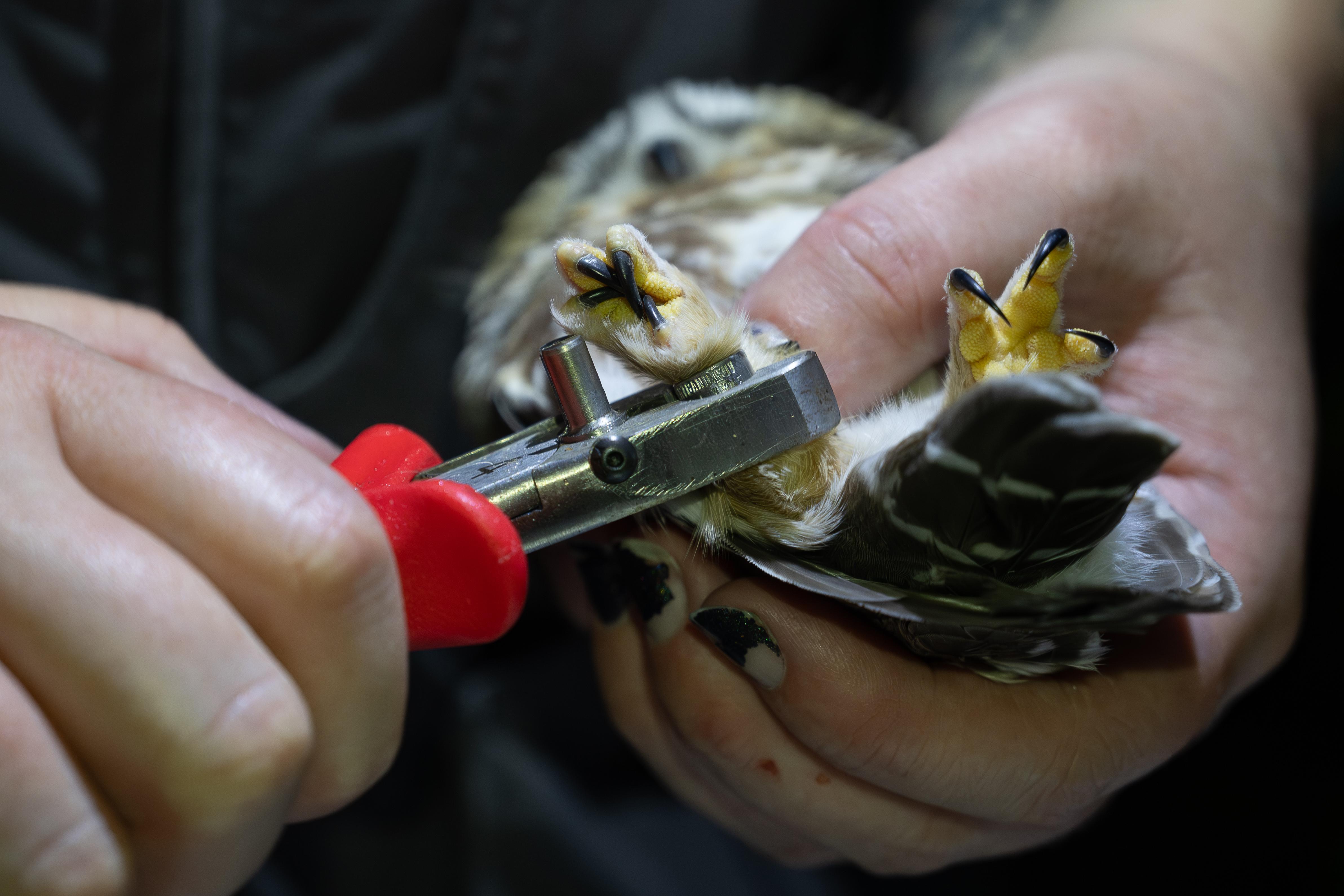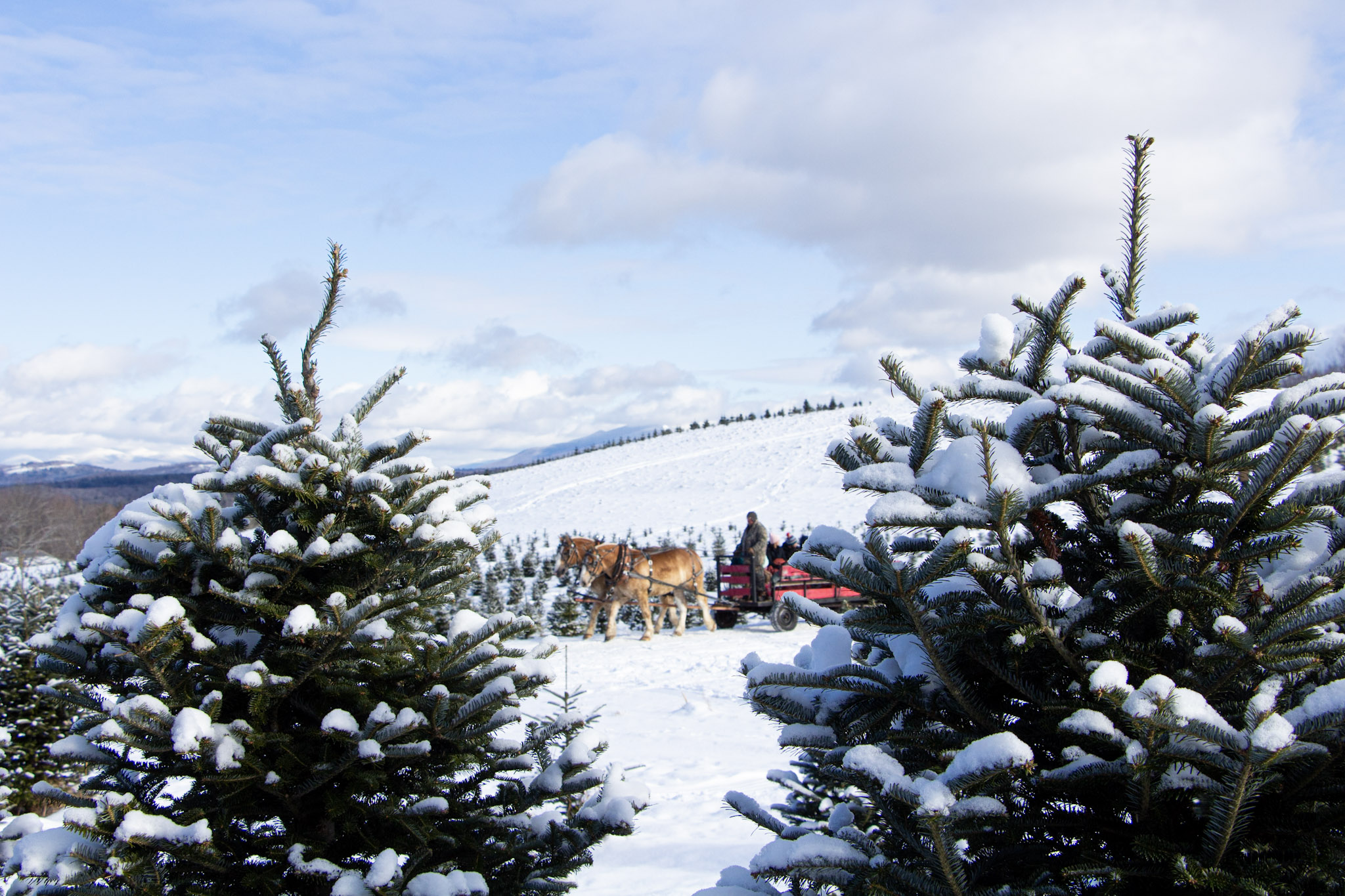- Tags:
- Forest Journal,
- Education,
- Wildlife

Examining the wear and condition of flight feathers is helpful in determining an owl’s age. Owls can’t molt all their flight feathers at once, as it would render them unable to fly, so they molt a few flight feathers each year in predictable patterns. (Dotty Holcomb Doherty)
The northern saw-whet owl may well be the cutest animal in New Hampshire’s forests. It’s also one of the most elusive.
On a recent field trip to the Black Mountain Banding Station in Sutton to observe saw-whet owl banding, station founder and licensed bander Lindsay Herlihy queried the group of 15 assembled participants, “How many of you have actually seen a saw-whet owl in the wild?”
Two people lifted their hands.
“Wow,” Herlihy exclaimed, “That’s more hands than I usually see!”
Northern saw-whet owls are solitary, secretive, and fully nocturnal, and they’re also very small — about the size of a softball if you’re including all their feathers, generously fluffed out.
All of this makes saw-whets less likely for people to encounter than some of our state’s other owl species like barred or great horned owls.
On the night of this particular field trip, however, participants were in for a treat — they were able to see nine individual saw-whet owls up close (of 15 banded that night!) and collectively delight in their diminutive adorableness.
The Black Mountain Banding Station (BMBS), which was established in 2024 on the Forest Society’s Black Mountain Forest to monitor breeding bird populations through the Monitoring Avian Productivity & Survivorship Program, is now also participating in Project Owlnet.
Project Owlnet began in the 1990s as a way to collaborate and share data and information about northern saw-whet owl migration banding. More than 125 banding stations across Canada and the United States are actively collecting data on these pint-sized owls, including several in New Hampshire like BMBS in Sutton and the Harris Center for Conservation Education in Hancock.
Why? Although saw-whet owl populations are thought to be healthy and stable, there is still a lot that we don’t know about the birds’ biology, habitat use, and migration behavior.
“These owls are so elusive during their non-migratory period, and so hard to observe that it’s difficult to study them outside of migration,” says Herlihy. “Project Owlnet is one of the few studies that is attempting to do total population monitoring during migration.” We can help unravel some of these mysteries — such as how long the owls live, how far, fast and when they migrate, and whether they have set migration routes — with more data from banding stations.
How to catch an owl
In order to band and release an owl, you first have to capture it. Saw-whet owl banding stations accomplish this with the help of an audio lure and ultra fine nylon nets called mistnets set up in appropriate habitat.
The audio lure plays a male saw-whet’s courtship call, a whistled “toot — toot — toot” that sounds somewhat like a saw being sharpened on a whetstone. As owls approach to investigate who is calling, they fly into the mistnets, from which they are carefully extracted by trained station volunteers.
From there, it is Herlihy’s duty as BMBS’s lead bander to affix a lightweight and uniquely numbered aluminum band on each owl’s right foot, and to weigh, measure, sex and age each bird.

Special banders pliers are used to affix a lightweight, numbered aluminum band to an owl’s feathery foot. The bands, supplied by the federal government, fit into the pliers perfectly so that the pliers can close but can never squeeze beyond the circumference of the band. (Dotty Holcomb Doherty)
All banding, marking, and sampling is conducted under a federally authorized Bird Banding Permit issued by the U.S. Geological Survey’s Bird Banding Laboratory, and a bander’s first priority is the safety of the birds.
“We do everything we can to minimize a bird’s stress and make sure that every saw-whet is released unharmed, though maybe with a crazy alien encounter story to tell their mate next breeding season,” Herlihy says.
Unintended catches
Sometimes flying squirrels, bats, and other nocturnal animals also encounter the mistnets at a saw-whet owl banding station. This isn’t ideal, as unlike owls, many of these other animals can chew, and they aren’t afraid to employ their gnashers on the delicate mistnets.
To keep an ear out for this sort of activity, as well as for owls that might enter the nets, one volunteer is always stationed close to the mistnet array, in what is fondly referred to as the “stakeout chair.”
The first area where BMBS set up nets this fall was quickly abandoned for a new site after it became apparent that northern flying squirrels were extremely abundant. Flying squirrels — who, incidentally, could give saw-whet owls a serious run for their money for both the cutest and most elusive awards — are also incredibly difficult to extract from mistnets without getting bitten (which requires precautionary rabies treatment) and/or cutting a huge hole in the net.
“I learned the hard way that they can chew right through leather work gloves,” Herlihy recalls. “Two fully ruined mistnets and a series of rabies shots later, I decided to relocate the nets.”
Mapping migration
Decades of Project Owlnet banding data is already leading to a better understanding of saw-wet owl migration. We now know that migration distance varies both by the year and by where the owl’s breeding territory is.
“Our saw-whet owls that breed in New Hampshire may go as far south as the Carolinas or Georgia,” says Herlihy, “while at the same time some owls that breed in the boreal forests of Canada may overwinter here.” There also appear to be age-differentiated migration trends, with juvenile owls in some regions migrating later than adults.
One mystery that remains to be solved is why the vast majority of all owls captured and banded across all Project Owlnet banding stations are female. Saw-whet owl sexes don’t look overtly different, but females are slightly larger, and using a combination of wing length and mass of the bird, it is possible to determine the sex of most captured individuals.
It may be that females are attracted to the audio lure in greater numbers since it is a male’s breeding song, but there is also mounting evidence that females migrate in greater numbers and for longer distances, while males remain on or near their breeding territory.
In the future, Herlihy has plans to employ more sophisticated technology at BMBS and contribute to a migratory connectivity project that uses radio telemetry or cellular tracking tags to monitor the migration of saw-whet owls in real time. The tags are expensive, ranging from $300 to $1,700 per tag depending on the technology, but if sufficient funds can be raised Herlihy hopes to begin this parallel project during the 2026 spring migration season in February and March.
If you are interested in seeing the owl banding process in action, the Forest Society also has plans for additional field trips during this same timeframe. You’ll want to bundle up, as March nights can be frosty and snow-covered, but the cuteness reward will melt your heart if not your chilly fingers and toes!
Keep an eye out at www.forestsociety.org/events as dates are posted.
More information about BMBS and volunteering at the station can be found at https://tinyurl.com/blackmtnbanding.
(Saw-whet owl banding at BMBS has been generously supported by funding from the Nuttall Ornithological Club’s Blake-Nuttall Grant program.)
